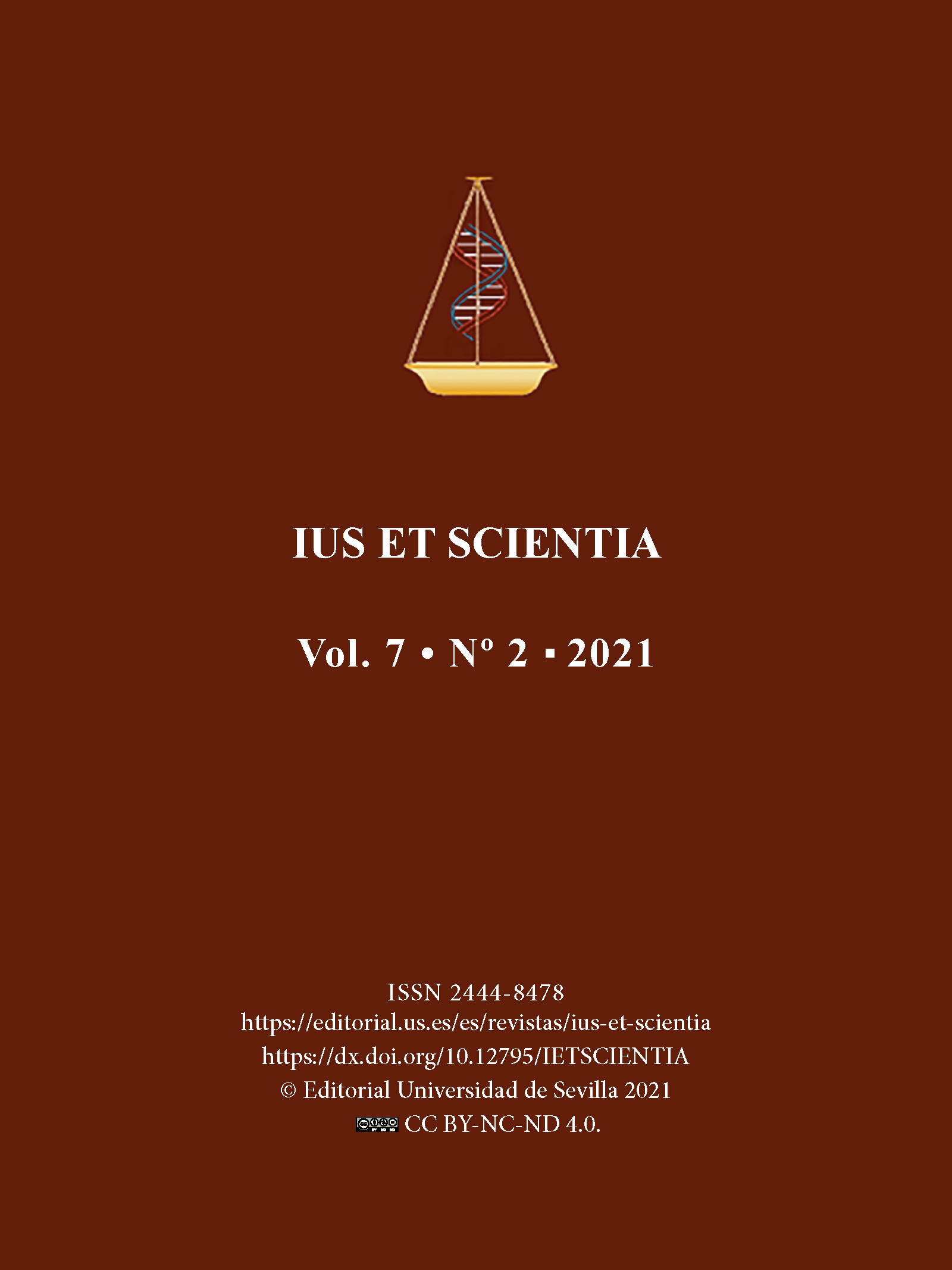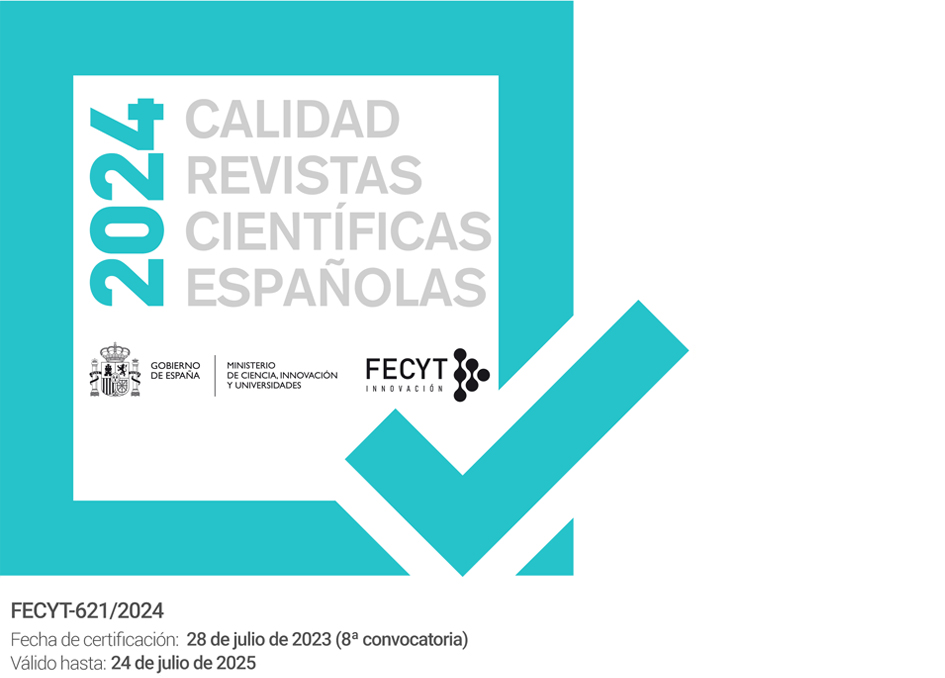Challenges of the forensic science facing new technologies
DOI:
https://doi.org/10.12795/IETSCIENTIA.2021.i01.05Palabras clave:
Ciencia forense, Inteligencia Artificia, Procedimiento de investigación, Recopilación de pruebas, Evidencia científica, Procedimiento PenalResumen
En la era de las nuevas tecnologías, utilizadas en el ámbito de la justicia penal, la ciencia forense ha superado retos reales a los que se enfrentan esos medios de recopilación y administración de pruebas científicas en los procesos penales. La inteligencia artificial y cómo se enfrenta al poder judicial es una pregunta bien conocida para la alta tecnología en el campo. El presente trabajo tiene como objetivo analizar y discutir los rasgos que
Descargas
Citas
Alamoreanu, S., Lazar, A. and Fratila, A. (2014). Despre criteriile de validitate ale expertizelor criminalistice. In R. M. Stanoiu, E. Stanisor (Eds.), Criminalitatea si Mediul, (pp. 143-148). Bucharest, Universul Juridic Publishing House.
Angele, C. (2017). Algorithms in practice: Comparing web journalism and criminal justice. Big Data and Society, 4(2), 1-14.
Ashworth, A. (2015). Sentencing and criminal justice, 6th ed. Cambridge, University Press.
Avdija, A. S. (2019). Police response to homicide crime scene: Testing the effect of the number of police officers and investigators responding to an active crime scene on the arrest success rate. Journal of Criminal Justice and Security, 2, 101-114. https://www.fvv.um.si/rv/arhiv/2019-2/01_Avdija_rV_2019-2.pdf
Balkin, J. M. (2017). The three laws robotics in the age of big data. Ohio State Law Journal, 78, 1217-1241. https://digitalcommons.law.yale.edu/
Barfield, W. and Pagallo, U. (2018). Research Handbook on the law of artificial intelligence, Edward Elgar Publishing.
Boister, N. (2018). An introduction to transnational criminal law, 2nd ed. Oxford, Oxford University Press.
Bouchaud, F., Grimaud, G., Vantroys, T. and Buret, P. (2019). Digital Investigation of IoT Devices in the Criminal Scene. Journal of Universal Computer Science, 25 (9), 1199-1218. https://hal.archives-ouvertes.fr/hal-02432740/document
Decision no. 253/A/2020 of 28 September 2020, High Court of Cassation and Justice of Romania. https://www.scj.ro
Decision no. 101/A/2019 of 27 March 2019. High Court of Cassation and Justice of Romania. https://www.scj.ro
Decision no. 428/RC/2018 of 28 November 2018.High Court of Cassation and Justice of Romania. https://www.scj.ro
Decision no. 385/RC/2018 of 31 October 2018, High Court of Cassation and Justice of Romania. https://www.scj.ro
Decision no. 297/A/2018 of 14 November 2018, High Court of Cassation and Justice of Romania. https://www.scj.ro
Decision no. 172/A/2018 of 4 July 2018, High Court of Cassation and Justice of Romania. https://www.scj.ro
Decision no. 530/2017, Court of Law of Dolj. http://portal.just.ro/
Douglas, J. E., Burgess, A. W., Burgess, A. G. and Ressler, R. K. (2013). Crime Classification Manual. A Standard System for Investigating and Classifying Violent Crime, New Jersey, Wiley. https://books.google.ro/s?hl=en&lr=&id=j4CNiiDyOFQC&oi=fnd&pg=PT18&dq=forensic+examination+in+organized+crimes.+&ots=aEyLgC7Qsh&sig=0gkjW3z67wroAQAW2oz933cZDm8&redir_esc=y#v=onepage&q=forensic%20examination%20in%20organized%20crimes.&f=false
Dzehtsiarou, K. (2011). European Consensus and the Evolutive Interpretation of the European Convention on Human Rights. German Law Journal, 12(10), 1730-1745. https://doi.org/10.1017/S2071832200017533. https://www.cambridge.org/core/services/aop-cambridge-core/content/view/D88583501DDB0D3CE42EBD6F6F925A21/S2071832200017533a.pdf/european_consensus_and_the_evolutive_interpretation_of_the_european_convention_on_human_rights.pdf
Ewald, U. (2019). Digital forensics vs. Due process: conflicting standards or complementary approaches?, New York, Association of Computing Machinery.
European Commission for the Efficiency of Justice. (2018). European ethical Charter for the use of Artificial Intelligence in the systems and their environment, Annex II, Council of Europe. Strasbourg, CEPEJ. https://rm.coe.int/ethical-charter-en-for-publication-4-december-2018/16808f699c
European Convention on Human Rights. (1950). Council of Europe. Strasbourg, Cedex, entered into force in 1953. https://www.echr.coe.int/documents/convention_eng.pdf
Gladysheva, O. V., Kostenko, R. V. and Sementsov, V. A. (2019). Digitization: problems of use and protection of information in criminal proceedings. In E. G. Popkova (Ed.), Ubiquitous computing and the internet of things: prerequisites for the development of ITC (pp. 395-401). Cham, Springer.
Gless, S. (2013). Transnational Cooperation in Criminal Matters and the Guarantee of a Fair Trial: Approaches to a General Principle, Utrecht Law Review, 9(4), 90-108. http://doi.org/10.18352/ulr.244
Guimaraes, R. R. C. (2019). The artificial intelligence and the dispute for different ways in its predictive use in the criminal process, Revista Brasileira de Direito Processual Penal, 5(3), 1555-1588. https://doi.org/10.22197/rbdpp.v5i3.260
Hilgendorf, E. (2018). Introduction: Digitization and the law - A European perspective. In E. Hilgendorf, J. Feldle (Eds.), Digitization and the law (pp. 9-19). Auflage, Nomos.
Janaki, M. C. (2016). Digitalization of investigation and detection of crime, Digital India: Rhetoric & Reality Edited Book.
Katz, D. M. (2013). Quantitative legal prediction - or - how I learned to stop worrying and start preparing for the data-driven future of the legal services industry. Emory Law Journal, 62, 909-966. https://scholarlycommons.law.emory.edu/elj/vol62/iss4/6
Lageson, S. E. (2019). Creating digital legal subjects: the use of online criminal court records for research. In S. M. Sterett and L. D. Walker (Eds.), Research handbook on law and courts, (pp. 394-403). Edward Elgar Publishing.
Law no. 135/2010 on the Code of Criminal procedure of Romania, published in the Romanian Official Journal no. 486 of 15 July 2010, into force from 1 February 2014.
Lazareva V. A., Olinder N. V. and Perekrestov V. N. (2019). Digital information in criminal proceedings: the concept end evidential significance. In E. G. Popkova (Ed.), Ubiquitous computing and the internet of things: prerequisites for the development of ITC (pp. 93-100). Cham, Springer.
Mittelstadt, B. D., Allo, P., Taddeo, M., Wachter, S. and Floridi L. (2016). The ethics of algorithms: mapping the debate, Big Data and Society, 3(2), 1-21. https://doi.org/10.1177/2053951716679679
Negri, D. (2019). New technologies and restriction of personal freedom: electronic surveillance and the accused placed under a precautionary measure. Revista Brasileira de Direito Processual, 5(3), 1255-1275. https://doi.org/10.22197/rbdpp.v5i3.289
Nieva Fenoll, J. (2018). Inteligencia artificial y proceso judicial. Madrid, Marcial Pons.
Pedrina, G. M. L. (2019). Consequences and prospects of the application of artificial intelligence to criminal cases. Revista Brasileira de Direito Processual, 5(3), 1589-1606. https://doi.org/10.22197/rbdpp.v5i3.265
Quattrocolo, S. (2019). An introduction to AI and criminal justice in Europe. Revista Brasileira de Direito Processual, 5(3), 1519-1554. https://doi.org/10.22197/rbdpp.v5i3.290
Sourdin, T. (2018). Judge v robots? Artificial intelligence and judicial decision-making. UNSW Law Journal, 41(4), 1114-1133. http://www.unswlawjournal.unsw.edu.au/wp-content/uploads/2018/12/Sourdin.pdf
Zavrsnik, A. (2018). Big data and Social control. Abingdon, Rutledge.
Descargas
Publicado
Cómo citar
Número
Sección
Licencia
Aquellos autores/as que tengan publicaciones con esta revista, aceptan los términos siguientes:- Los autores/as conservarán sus derechos de autor y garantizarán a la revista el derecho de primera publicación de su obra, el cuál estará simultáneamente sujeto a la Licencia de reconocimiento de Creative Commons que permite a terceros compartir la obra siempre que se indique su autor y su primera publicación esta revista.
- Los autores/as podrán adoptar otros acuerdos de licencia no exclusiva de distribución de la versión de la obra publicada (p. ej.: depositarla en un archivo telemático institucional o publicarla en un volumen monográfico) siempre que se indique la publicación inicial en esta revista.
- Se permite y recomienda a los autores/as difundir su obra a través de Internet (p. ej.: en archivos telemáticos institucionales o en su página web) antes y durante el proceso de envío, lo cual puede producir intercambios interesantes y aumentar las citas de la obra publicada. (Véase El efecto del acceso abierto).




